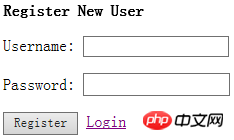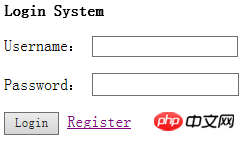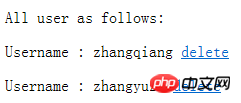Basic skills in PHP+MariaDB database operation
This article mainly introduces the basic skills of PHP MariaDB database operation. It summarizes and analyzes PHP MariaDB database connection, judgment, and related operation implementation skills and precautions based on PHP MariaDB such as user login, management, and deletion based on PHP MariaDB. It is necessary to Friends can refer to
The examples in this article summarize the basic skills of PHP MariaDB database operation. I share it with you for your reference. The details are as follows:
PHP MySQL is a relatively common combination. Since I subjectively don’t like Oracle very much, and after MySQL was acquired by Oracle, some changes have occurred in my bones, so I changed it. MariaDB, a brother who still adheres to MySQL's original open source belief. They are essentially the core of MySQL, so all the following database operation codes can be used directly in MySQL.
After setting up the basic environment of PHP Apache and installing the MySQL database at night, I wrote the simplest database connection code, and the result was the following classic error: Fatal error: Class 'mysqli' not found
<?php
$db = new mysqli('localhost', 'root', 'admin', 'test');
if (mysqli_connect_errno())
{
echo '<p>' . 'Connect DB error';
exit;
}
?>In fact, this problem is relatively simple. From the error returned by the PHP engine, we know that mysqli has not been loaded correctly. Most of the problems are This happened in the configuration of the php.ini file. The default semicolon in front of the configuration item "extension=php_mysqli.dll" was not removed. I didn't make this mistake. There is also the file php_mysqli.dll in the ext directory in the PHP installation path. So where did the problem occur? The problem should still occur in the wrong place in the php.ini file. After some reading, I found that "extension_dir = "ext"" has not been modified. I didn't think much about it at the time, thinking that the PHP engine could automatically find this relative path. But then I thought about it, the PHP engine is loaded by Apache, and Apache does not know this relative relationship. Or honestly change this place to an absolute path, and it's OK. In fact, you can write this piece of code before this code to see if the mysqli component has been loaded. This method is suitable for pre-loading judgment of other components.
if (extension_loaded('mysqli'))
{
echo 'yes';
}
else
{
echo 'no';
}The following uses a user registration and system login to record the most basic operation method of PHP MySQL.
1. Create database, tables and users.
DROP DATABASE IF EXISTS `test`; CREATE DATABASE `test` USE `test`; DROP TABLE IF EXISTS `tbl_user`; CREATE TABLE `tbl_user` ( `username` varchar(32) NOT NULL default '', `password` varchar(32) NOT NULL default '', PRIMARY KEY (`username`) ) ENGINE=InnoDB DEFAULT CHARSET=gb2312;
2. Create registration and login html pages, which are register.html and login.html respectively. As shown in the figure below:


3. Registration and login code:
register_do.php
<?php
$username = $_POST['username'];
$password = $_POST['password'];
$db = new mysqli('localhost', 'root', 'admin', 'test');
if (mysqli_connect_errno())
{
echo '<p>' . 'Connect DB error';
exit;
}
$query = "select * from tbl_user where username = '" . $username . "'";
echo '<p>' . $query;
$result = $db->query($query);
if ($result)
{
echo '<p>' . 'The user '. $username .' exist';
echo '<p>' . '<a href="register.html" rel="external nofollow" rel="external nofollow" >Back to register</a>';
}
else
{
$query = "insert into tbl_user values ('". $username ."', '". $password ."')";
echo '<p>' . $query;
$result = $db->query($query);
if ($result)
{
echo '<p>' . '<a href="register.html" rel="external nofollow" rel="external nofollow" >Register successful</a>';
}
}
?>login_do.php
<?php
$username = $_POST['username'];
$password = $_POST['password'];
$db = new mysqli('localhost', 'root', 'admin', 'test');
if (mysqli_connect_errno())
{
echo '<p>' . 'Connect DB error';
exit;
}
$query = "select * from tbl_user where username = '" . $username . "' and password = '" . $password . "'";
echo '<p>' . $query;
$result = $db->query($query);
if ($result->num_rows)
{
echo '<p>' . '<a href="login.html" rel="external nofollow" rel="external nofollow" >Login successful</a>';
}
else
{
echo '<p>' . '<a href="login.html" rel="external nofollow" rel="external nofollow" >Login failed</a>';
}
?>userlist.php
<?php
$db = new mysqli('localhost', 'root', 'admin', 'test');
if (mysqli_connect_errno())
{
echo '<p>' . 'Connect DB error';
exit;
}
echo '<p>' . 'All user as follows:';
$query = "select * from tbl_user order by username";
if ($result = $db->query($query))
{
while ($row = $result->fetch_assoc())
{
echo '<p>' . 'Username : ' . $row['username'] . ' <a href="userdelete.php?username=' . $row['username'] . '" rel="external nofollow" >delete</a>';
}
}
?>4. The final display effect of the page is as shown below:

5. The code to delete the user:
userdelete.php
<?php
$username = $_GET['username'];
$db = new mysqli('localhost', 'root', 'admin', 'test');
if (mysqli_connect_errno())
{
echo '<p>' . 'Connect DB error';
exit;
}
$query = "delete from tbl_user where username = '" . $username . "'";
echo $query;
if ($result = $db->query($query))
{
echo '<p>' . 'Delete user ' . $username . ' successful';
}
else
{
echo '<p>' . 'Delete user ' . $username . ' failed';
}
echo '<p>' . '<a href="userlist.php" rel="external nofollow" >Back to user list</a>';
?>Prepare preprocessing
1. The book adding page is as shown below (bookadd.html):

2. The table creation script is as follows:
DROP DATABASE IF EXISTS `test`; CREATE DATABASE IF NOT EXISTS `test`; USE `test`; DROP TABLE IF EXISTS `tbl_book`; CREATE TABLE IF NOT EXISTS `tbl_book` ( `isbn` varchar(32) NOT NULL, `title` varchar(32) NOT NULL, `author` varchar(32) NOT NULL, `price` float NOT NULL, PRIMARY KEY (`isbn`) ) ENGINE=InnoDB DEFAULT CHARSET=utf-8;
3. The added logic processing code is as follows (bookadd_do.php ): What needs special attention here is the sentence "$db->query("set names utf-8")", which means that when writing data to the database, utf-8 encoding and decoding is used. Displays the encoding and decoding settings for database table operations to prevent Chinese garbled characters. I will record an article specifically on this technical point later.
<?php
$isbn = $_POST['isbn'];
$title = $_POST['title'];
$author = $_POST['author'];
$price = $_POST['price'];
$db = new mysqli('localhost', 'root', 'admin', 'test');
if (mysqli_connect_errno())
{
echo '<p>' . 'Connect DB error';
exit;
}
$db->query("set names utf-8"); //特别注意这句话
$stmt = $db->stmt_init();
$stmt->prepare("insert into tbl_book values (?,?,?,?)");
$stmt->bind_param("sssd", $isbn, $title, $author, $price);
$stmt->execute();
echo '<p>' . 'Affect rows is ' . $stmt->affected_rows;
echo '<p>' . '<a href="booklist.php" rel="external nofollow" >Go to book list page</a>';
?>4. The logic code for displaying book information is as follows. Also pay attention to the sentence "$db->query("set names utf- 8")":
<?php
$db = new mysqli('localhost', 'root', 'admin', 'test');
if (mysqli_connect_errno())
{
echo '<p>' . 'Connect DB error';
exit;
}
$db->query("set names utf-8"); //特别注意这句话
$stmt = $db->stmt_init();
$stmt->prepare("select * from tbl_book");
$stmt->bind_result($isbn, $title, $author, $price);
$stmt->execute();
while($stmt->fetch())
{
echo 'ISBN : ' . $isbn . '<p>';
echo 'Title : ' . $title . '<p>';
echo 'Author : ' . $author . '<p>';
echo 'Price : ' . $price . '<p>';
echo '<p>' . '-----------------------------' . '<p>';
}
?>5. The displayed page is as shown below:

PHP database operation class based on pdo
Contents related to mysql read-write separation implemented by PHP
PHP implements the method of compressing multiple files into zip format and downloading them locally
The above is the detailed content of Basic skills in PHP+MariaDB database operation. For more information, please follow other related articles on the PHP Chinese website!

Hot AI Tools

Undresser.AI Undress
AI-powered app for creating realistic nude photos

AI Clothes Remover
Online AI tool for removing clothes from photos.

Undress AI Tool
Undress images for free

Clothoff.io
AI clothes remover

Video Face Swap
Swap faces in any video effortlessly with our completely free AI face swap tool!

Hot Article

Hot Tools

Notepad++7.3.1
Easy-to-use and free code editor

SublimeText3 Chinese version
Chinese version, very easy to use

Zend Studio 13.0.1
Powerful PHP integrated development environment

Dreamweaver CS6
Visual web development tools

SublimeText3 Mac version
God-level code editing software (SublimeText3)

Hot Topics
 Explain JSON Web Tokens (JWT) and their use case in PHP APIs.
Apr 05, 2025 am 12:04 AM
Explain JSON Web Tokens (JWT) and their use case in PHP APIs.
Apr 05, 2025 am 12:04 AM
JWT is an open standard based on JSON, used to securely transmit information between parties, mainly for identity authentication and information exchange. 1. JWT consists of three parts: Header, Payload and Signature. 2. The working principle of JWT includes three steps: generating JWT, verifying JWT and parsing Payload. 3. When using JWT for authentication in PHP, JWT can be generated and verified, and user role and permission information can be included in advanced usage. 4. Common errors include signature verification failure, token expiration, and payload oversized. Debugging skills include using debugging tools and logging. 5. Performance optimization and best practices include using appropriate signature algorithms, setting validity periods reasonably,
 PHP and Python: Comparing Two Popular Programming Languages
Apr 14, 2025 am 12:13 AM
PHP and Python: Comparing Two Popular Programming Languages
Apr 14, 2025 am 12:13 AM
PHP and Python each have their own advantages, and choose according to project requirements. 1.PHP is suitable for web development, especially for rapid development and maintenance of websites. 2. Python is suitable for data science, machine learning and artificial intelligence, with concise syntax and suitable for beginners.
 MySQL: Simple Concepts for Easy Learning
Apr 10, 2025 am 09:29 AM
MySQL: Simple Concepts for Easy Learning
Apr 10, 2025 am 09:29 AM
MySQL is an open source relational database management system. 1) Create database and tables: Use the CREATEDATABASE and CREATETABLE commands. 2) Basic operations: INSERT, UPDATE, DELETE and SELECT. 3) Advanced operations: JOIN, subquery and transaction processing. 4) Debugging skills: Check syntax, data type and permissions. 5) Optimization suggestions: Use indexes, avoid SELECT* and use transactions.
 PHP: A Key Language for Web Development
Apr 13, 2025 am 12:08 AM
PHP: A Key Language for Web Development
Apr 13, 2025 am 12:08 AM
PHP is a scripting language widely used on the server side, especially suitable for web development. 1.PHP can embed HTML, process HTTP requests and responses, and supports a variety of databases. 2.PHP is used to generate dynamic web content, process form data, access databases, etc., with strong community support and open source resources. 3. PHP is an interpreted language, and the execution process includes lexical analysis, grammatical analysis, compilation and execution. 4.PHP can be combined with MySQL for advanced applications such as user registration systems. 5. When debugging PHP, you can use functions such as error_reporting() and var_dump(). 6. Optimize PHP code to use caching mechanisms, optimize database queries and use built-in functions. 7
 Explain the match expression (PHP 8 ) and how it differs from switch.
Apr 06, 2025 am 12:03 AM
Explain the match expression (PHP 8 ) and how it differs from switch.
Apr 06, 2025 am 12:03 AM
In PHP8, match expressions are a new control structure that returns different results based on the value of the expression. 1) It is similar to a switch statement, but returns a value instead of an execution statement block. 2) The match expression is strictly compared (===), which improves security. 3) It avoids possible break omissions in switch statements and enhances the simplicity and readability of the code.
 What is Cross-Site Request Forgery (CSRF) and how do you implement CSRF protection in PHP?
Apr 07, 2025 am 12:02 AM
What is Cross-Site Request Forgery (CSRF) and how do you implement CSRF protection in PHP?
Apr 07, 2025 am 12:02 AM
In PHP, you can effectively prevent CSRF attacks by using unpredictable tokens. Specific methods include: 1. Generate and embed CSRF tokens in the form; 2. Verify the validity of the token when processing the request.
 PHP in Action: Real-World Examples and Applications
Apr 14, 2025 am 12:19 AM
PHP in Action: Real-World Examples and Applications
Apr 14, 2025 am 12:19 AM
PHP is widely used in e-commerce, content management systems and API development. 1) E-commerce: used for shopping cart function and payment processing. 2) Content management system: used for dynamic content generation and user management. 3) API development: used for RESTful API development and API security. Through performance optimization and best practices, the efficiency and maintainability of PHP applications are improved.
 PHP's Purpose: Building Dynamic Websites
Apr 15, 2025 am 12:18 AM
PHP's Purpose: Building Dynamic Websites
Apr 15, 2025 am 12:18 AM
PHP is used to build dynamic websites, and its core functions include: 1. Generate dynamic content and generate web pages in real time by connecting with the database; 2. Process user interaction and form submissions, verify inputs and respond to operations; 3. Manage sessions and user authentication to provide a personalized experience; 4. Optimize performance and follow best practices to improve website efficiency and security.






